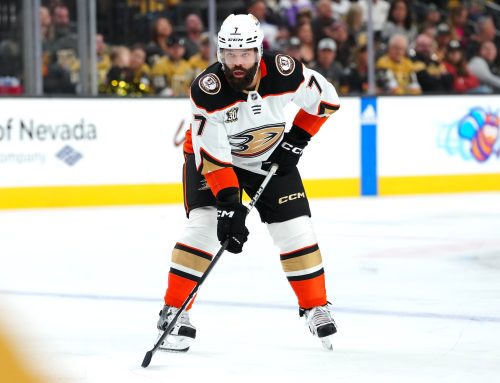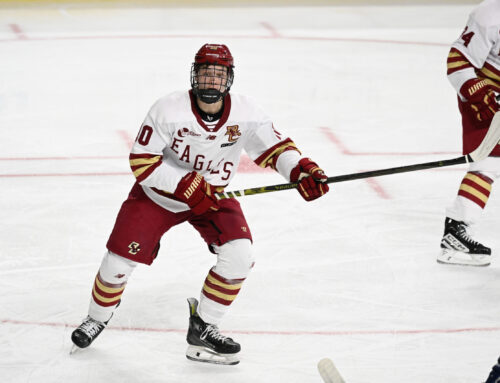
Every year, there are players who either breakout for a huge fantasy season seemingly out of nowhere or players who reclaim their former fantasy glory. In other words, there are always players who provide a lot of fantasy value by being underappreciated by the public.
That is an obvious paragraph; of course there are always fantasy options that provide immense value. That’s nothing new in fantasy hockey or fantasy sports in general. Going about finding that value, however, is a completely different story, and often means the difference between winning and losing.
In an attempt to (hopefully) help out the readers heading into their drafts, I thought it would be worthwhile to go through my process on how I search for value in fantasy hockey. Some of it may be straightforward, some less so. My hope is that something can be gleaned by everyone to help not only this year but in seasons to come.
Always check rankings sources
For those that read my Ramblings discussing the Yahoo rankings, you already know this. Other may just be doing it already. Either way, it is vitally important to know where the public is going and what the perception of certain players are.
(*quick note here that this is much more applicable to home leagues than to public leagues. There is no way to tell the level of knowledge from 11 strangers in an ESPN lobby, but if you’re playing with 11 buddies every year, you probably know where they get their information.)
It’s important to take note of both Yahoo and ESPN rankings, as a lot of people who rush last-minute on their studying will just take the rankings from popular sites. Also, make sure you have your Dobber guide, and try to learn who else has them. There’s also FantasyPros, a site that aggregates rankings of fantasy analysts.
Once you know where the public is heading – maybe three or four sources are all high on the same “sleeper” player, which means he won’t be a sleeper by the time drafts come around – you know which players are probably going to be priced too high, and which are going overlooked.
Keep Track of Average Draft Position
Mock drafts have started on Yahoo, but they really won’t ramp up between them and ESPN until at least training camp starts. Football is still king, and most people who play both fantasy hockey and fantasy football will give precedence over the latter at least until mid-September.
There is no reason why, though, to not note where players are being drafted now, and then check to see where these same players are being drafted in two weeks, or a month. Suppose Alex Radulov isn’t skating with Tyler Seguin and Jamie Benn in camp, that will probably affect his ADP. Maybe Ales Hemsky is on the top line in Montreal for exhibition games. Or perhaps someone tweaks a knee and is going to be out a couple weeks. This all affects ADP and in turn the value they can bring at drafts.
Also, relating to the previous paragraph, sometimes a player gets hyped so much by analysts and fantasy owners that the value is taken out of the draft pick, and ADP data will tell us this. For a practical example, there were a lot of analysts (present company included) that were very high on Tyler Toffoli going into the 2015-16 season. At the start of draft season in early September, he was going somewhere in the 10th or 11th round of 12-team leagues. As more people read more articles about how good Toffoli was and the potential breakout season in store, his ADP rose to the point where I was seeing him drafted in the seventh round of drafts. He still had a great season and thankfully he returned value on that inflated pick in roto leagues, but the lesson is that if you track ADP data, you can determine when an undervalued player starts being overvalued, and vice versa.
Make a list of proven players coming off poor seasons and start investigating
Okay that second part might be asking a bit much. I know that fantasy hockey is a hobby for the vast majority of people, and you all have jobs, families, and other responsibilities that divide your time. In that sense, spending dozens of hours researching players isn’t realistic. Let us here at Dobber do that; the guide helps, and there are lots of articles and Ramblings that can also aid in this regard.
Should you have the time, though, once the kids are in bed, one of the most valuable pieces of advice I received in fantasy came years ago when I first started taking any sport seriously, and it was exactly what the headline says: make a list of proven players coming off poor seasons. By nature, humans are reactionary, and recency bias is a hell of a drug. It’s why Sergei Bobrovsky is probably going to be a top-5 goalie off the board this year when he was a top-20 goalie off the board last year.
So make a list: Anze Kopitar, Taylor Hall, Oliver Ekman-Larsson, to name a few. There are dozens, of course, but those are to just to get started. Why did they underperform? Was it shooting percentage? Their team’s shooting percentage? Injuries to key players on the team? New line mates? Or, likely, a combination of these and other things? Sometimes there’s a pretty easy explanation – Patrick Sharp is getting old – but often it’s more complicated. There are numerous situations where the situation or skills haven’t really changed, players just have unlucky years. They are frequently undervalued, and those players can be league-winning draft picks.
Brush up on stats that can help point you in the right direction
Being the ever-intelligent fantasy community that you are, I know many of you are already versed in a lot of stats I use in my Ramblings. For those that may be coming to us for the first time, here are a few things I look for. Again, some obvious, some less so.
Individual shooting percentage
This is one of the more obvious ones. Jakub Voracek shot 5.2 percent in 2015-16, and rebounded to 7.9 percent last year; Torey Krug was a career 6.6 percent shooter going into 2015-16 and then shot 1.6 percent, after which he predictably rebounded. And on and on and on.
I will say that it isn’t so simple as just seeing a low shooting percentage from a player and assuming it’ll just rebound significantly. Mentioned above was Voracek, and he didn’t come around as much as we were expecting; I wrote in July about how Claude Giroux changed his shot positioning on the power play and that was a big reason for his overall shooting percentage decline compared to earlier in his career. Just seeing a decline in shooting percentage from established career norms doesn’t mean it will rebound. It probably will, but further investigation is always required.
On-ice shooting percentage
This is just the rate of conversion by a team with a given player on the ice, almost always expressed at five-on-five. If a team is well-below league average in shot conversion with a player on the ice, that player is unlikely to amass as many goals and assists as we may hope. This is much more relevant for players that are on the same team one year to the next with largely the same cast (like the aforementioned Kopitar) than players that switch teams (like the aforementioned Hall).
A big reason why Kopitar only had 26 points at five-on-five last year (he had 44 the year before) was that the team scored at a five-year-low rate with him on the ice. Part of this is he was stuck more in a defensive role having to carry a line, part of it is the team’s inability to generate scoring chances. It’s different for Hall, who went from playing with Ryan Nugent-Hopkins or Connor McDavid to Travis Zajac or Adam Henrique. But both still set five-year lows.
This requires a lot more investigation than just looking at a number. Was the team generating scoring/high-danger chances with that player on the ice? Did the player’s role change, and who did he play with? Those are just a couple questions to start digging into.
Whatever the reason, if a team is subpar at generating and finishing, it will often lead to subpar fantasy performances. Figuring out why, and if it will change, is very important.
Time On Ice
It always amuses me – I’m easily amused – how important ice time is and yet how often it is overlooked by fans and analysts alike. It is so obvious just how crucial it is for a player’s production and yet it’s something that is not often discussed. Even something as simple as saying “he’s a middle-six player” can be deceiving because some top-heavy teams (and I use that term because I can’t think of a better one) will player some players on the second line much more than the third. Teams like Anaheim and Washington are examples of this, where the least-used second-liner gets over a minute more of five-on-five time per game than the most-used third liner, which means the average ice time between the two lines is even greater than that.
Consider this: a player playing 16 minutes a game and playing all 82 games will player 1312 minutes in a season. Over the last three years, only one player has cracked 70 points while playing that number of minutes or less and it was Evgeni Malkin (he did it twice), while only 12 players total have cracked 60 points. Hundreds finished below 50 points. On the flipside, 18 minutes a game in a full 82-game season is 1476 minutes. Over the last three years, the same number of players with at least 1476 minutes of ice time cracked 80 points (12) as cracked 60 points with 1312 minutes or less. Over half the player to reach that mark cracked 60 points.
Always check to see the ice time of a player. Was it more or less than the year before, and how was it allocated? Meaning that if he got less ice time, was he simply taken off the penalty kill, or did he lose power-play time? The context of the ice time is important with the raw number as well.
****
Hopefully this helps some people. I could write thousands upon thousands of words on this, but this should give the readers a good outline on what I look for and how it can help in fantasy. Follow this quick guide, put in some work when possible, and it should help you too.
One Comment
Leave A Comment
You must be logged in to post a comment.





 FLA
FLA CHI
CHI NYR
NYR PIT
PIT L.A
L.A COL
COL CAR
CAR OTT
OTT TOR
TOR NYI
NYI
 MIN
MIN BOS
BOS CGY
CGY

Time On Ice is one of the stats I heavily lean on. One of the main reasons other than the obvious correlation between being able to get points and actually being on the ice are two things. The first being the “confidence” of the couch and/or management, particularly in young players, basically a free scouting report. The second is a bit less so, but in our league we count +/-, and on a *good* team, some players can rack up points simply by being on the ice a lot when their team is successful.